A Multi-Factor Framework for Cold-Climate Campus Design and Student Health
Abstract
1. Introduction
1.1. Theoretical Foundation
1.1.1. Evidence-Based Design Theory
1.1.2. Socio-Ecological Model
1.2. Research Objectives
- (1)
- To comprehensively identify and analyze the key determinants influencing student health within university campuses in cold regions of China.
- (2)
- To distinguish and evaluate the most significant environmental factors that have measurable impacts on student health in these contexts.
- (3)
- To propose specific guidelines for optimizing the physical environment of university campuses in cold climates, aiming to mitigate the negative health impacts of cold weather, enhance the health-supportive functions of campus environments, and provide scientific evidence and practical guidance for future planning and policy-making in related fields.
2. Methods
2.1. Research Framework
2.1.1. Extraction of Key Factors Through LDA Topic Modeling
2.1.2. Expert Evaluation via Delphi Method
2.1.3. Validation Through Representative Campus Case Studies
3. Results and Discussion
3.1. LDA Topic Modeling
3.1.1. Literature Screening
3.1.2. Textual LDA Topic Discovery
Data Cleaning
LDA Topic Modeling and Parameter Optimization
3.1.3. LDA Topic Data Analysis
Data Results
Textual Topic Analysis of Campus Environment and Student Health in Cold Regions
- Climatic Conditions and Student Health (Topic 0)
- Architectural Form and Student Health (Topic 1)
- Campus Infrastructure and Student Health (Topic 2)
- Natural Environment and Green Space (Topic 3)
- Campus Safety Factors and Student Health (Topic 4)
- Transportation and Accessibility (Topic 5)
3.1.4. Empirical Validation Results of the Structural Framework of LDA-Derived Influencing Factors
3.2. Collection and Analysis of Expert Opinions Using the Delphi Method
3.2.1. Expert Selection for the Delphi Method
3.2.2. Development Tools
3.2.3. Data Analysis and Results
3.3. Case Study on Health Promotion Mechanisms in Cold-Region University Campuses
3.3.1. Case Selection and Research Methods
3.3.2. Analytical Framework
3.3.3. Case Study Results and Analysis
Climate Adaptability
Built Environment Optimization
Landscape and Ecological Strategies
Safety and Accessibility Enhancement
3.3.4. Framework Validation and Theoretical Convergence
4. Conclusions and Recommendations
4.1. Empirical Findings on Environmental Intervention Strategies in Cold-Region Campuses
4.1.1. Positive Utilization of Climatic Conditions
4.1.2. Microclimate Regulation Through Built Environment
4.1.3. Influence of Winter Landscape on Perceived Environment and Behavior
4.1.4. Integrating Safety and Cultural Perception in Design
4.2. Theoretical and Practical Contributions
4.3. Research Limitations and Future Directions
4.4. Conclusions
Author Contributions
Funding
Institutional Review Board Statement
Informed Consent Statement
Data Availability Statement
Acknowledgments
Conflicts of Interest
References
- World Health Organization. Health as the Pulse of the New Urban Agenda: United Nations Conference on Housing and Sustainable Urban Development, Quito. 2016. Available online: https://apps.who.int/iris/bitstream/handle/10665/250367/9789241511445-eng.pdf (accessed on 7 November 2024).
- World Health Organization. Ottawa Charter for Health Promotion; WHO Regional Office for Europe: Copenhagen, Denmark, 1986. [Google Scholar]
- Downs, N.; Galles, E.; Skehan, B.M.; Lipson, S.K. Be True to Our Schools—Models of Care in College Mental Health. Curr. Psychiatry Rep. 2018, 20, 72. [Google Scholar] [CrossRef]
- Acharya, L.; Jin, L.; Collins, W. College life is stressful today—Emerging stressors and depressive symptoms in college students. J. Am. Coll. Health 2018, 66, 655–664. [Google Scholar] [CrossRef]
- Wang, B.; Sun, S.; Li, Y.; Xie, Y.N.; Hou, Y.X.; Jin, Q.T.; Ren, Y.Y. Campus wind environment evaluation in north China—A case study of NCUT. Energy Rep. 2020, 6, 787–793. [Google Scholar] [CrossRef]
- Kennedy, K.; MacLeod, E.; Lee, J.; Treige, C.; Jones, R. Identifying Barriers and Facilitators to Reporting and Disclosing Sexual Violence (SV) for Undergraduate Students in Canadian and American Universities: A Scoping Review Protocol. Syst. Rev. 2025, 14, 203. [Google Scholar] [CrossRef] [PubMed]
- Jayman, M.; Glazzard, J.; Rose, A.; Quickfall, A. Holistically Healthy Humans: Championing Mental and Physical Wellbeing in Education. Front. Educ. 2025, 10, 1722875. [Google Scholar] [CrossRef]
- Nahal, T.; Mitra, R. Facilitators and barriers to winter cycling: Case study of a downtown university in Toronto, Canada. J. Transp. Health 2018, 10, 262–271. [Google Scholar] [CrossRef]
- Chen, S.; Lu, M.; Tan, H.; Luo, X.; Ge, J. Assessing sustainability on Chinese university campuses: Development of a campus sustainability evaluation system and its application with a case study. J. Build. Eng. 2019, 24, 100747. [Google Scholar] [CrossRef]
- Ng, S.W.; Norton, E.C.; Popkin, B.M. Why have physical activity levels declined among Chinese adults? Findings from the 1991–2006 China Health and Nutrition Surveys. Soc. Sci. Med. 2009, 68, 1305–1314. [Google Scholar] [CrossRef]
- Atkin, A.J.; Sharp, S.J.; Harrison, F.; Brage, S.; van Sluijs, E.M.F. Seasonal Variation in Children’s Physical Activity and Sedentary Time. Med. Sci. Sports Exerc. 2016, 48, 449–456. [Google Scholar] [CrossRef]
- Sallis, J.F.; Cervero, R.B.; Ascher, W.; Henderson, K.A.; Kraft, M.K.; Kerr, J. An Ecological Approach to Creating Active Living Communities. Annu. Rev. Public Health 2006, 27, 297–322. [Google Scholar] [CrossRef]
- Kaplan, R.; Kaplan, S. The Experience of Nature: A Psychological Perspective; Cambridge University Press: Cambridge, UK, 1989. [Google Scholar]
- Ewing, R.; Handy, S. Measuring the Unmeasurable: Urban Design Qualities Related to Walkability. J. Urban Des. 2009, 14, 65–84. [Google Scholar] [CrossRef]
- Kellert, S.R.; Wilson, E.O. The Biophilia Hypothesis; Island Press: Washington, DC, USA, 1993. [Google Scholar]
- Lee, Y.S.; Guerin, D.A. Indoor Environmental Quality Related to Occupant Satisfaction and Performance in LEED-Certified Buildings. Indoor Built Environ. 2009, 18, 293–300. [Google Scholar] [CrossRef]
- Souter-Brown, G. Landscape and Urban Design for Health and Well-Being: Using Healing, Sensory and Therapeutic Gardens; Routledge: London, UK, 2015. [Google Scholar]
- Hamilton, D.K.; Watkins, D.H. Evidence-Based Design for Multiple Building Types; John Wiley & Sons: Hoboken, NJ, USA, 2008. [Google Scholar]
- Lyu, Z.; Zhu, X. Evidence-Based Design Research and Practice. Chin. Hosp. Archit. Equip. 2012, 13, 24. [Google Scholar]
- Fang, Y. Exploration of Evidence-Based Design Theory and Its Application in Chinese Healthcare Architecture. Master’s Thesis, Tianjin University, Tianjin, China, 2014. Available online: http://cdmd.cnki.com.cn/Article/CDMD-10056-1015018395.htm (accessed on 28 October 2025).
- Glanz, K.; Rimer, B.K.; Viswanath, K. (Eds.) Health Behavior and Health Education: Theory, Research, and Practice, 4th ed.; Jossey-Bass: San Francisco, CA, USA, 2008. [Google Scholar]
- Ajzen, I. The Theory of Planned Behavior. Organ. Behav. Hum. Decis. Process. 1991, 50, 179–211. [Google Scholar] [CrossRef]
- Bandura, A. Social Foundations of Thought and Action: A Social Cognitive Theory; Prentice-Hall: Englewood Cliffs, NJ, USA, 1986. [Google Scholar]
- Sallis, J.F.; Owen, N. Ecological Models. In Health Behavior and Health Education: Theory, Research, and Practice; Glanz, K., Lewis, F.M., Rimer, B.K., Eds.; Jossey-Bass: San Francisco, CA, USA, 1997; pp. 403–424. [Google Scholar]
- McLeroy, K.R.; Bibeau, D.; Steckler, A.; Glanz, K. An Ecological Perspective on Health Promotion Programs. Health Educ. Q. 1988, 15, 351–377. [Google Scholar] [CrossRef] [PubMed]
- Sallis, J.F.; Owen, N.; Fisher, E.B. Ecological Models of Health Behavior. In Health Behavior and Health Education: Theory, Research, and Practice, 4th ed.; Glanz, K., Rimer, B.K., Viswanath, K., Eds.; Jossey-Bass: San Francisco, CA, USA, 2008; pp. 465–485. [Google Scholar]
- Stokols, D. Establishing and Maintaining Healthy Environments: Toward a Social Ecology of Health Promotion. Am. Psychol. 1992, 47, 6–22. [Google Scholar] [CrossRef] [PubMed]
- Giles-Corti, B.; Vernez-Moudon, A.; Reis, R.; Turrell, G.; Dannenberg, A.L.; Badland, H.; Foster, S.; Lowe, M.; Sallis, J.F.; Stevenson, M.; et al. City Planning and Population Health: A Global Challenge. Lancet 2016, 388, 2912–2924. [Google Scholar] [CrossRef] [PubMed]
- Tucker, P.; Gilliland, J. The Effect of Season and Weather on Physical Activity: A Systematic Review. Public Health 2007, 121, 909–922. [Google Scholar] [CrossRef]
- Saelens, B.E.; Handy, S.L. Built Environment Correlates of Walking: A Review. Med. Sci. Sports Exerc. 2008, 40 (Suppl. S7), S550–S566. [Google Scholar] [CrossRef]
- Willwerth, J.; Sheahan, M.; Chan, N.; Fant, C.; Martinich, J.; Kolian, M. The Effects of Climate Change on Outdoor Recreation Participation in the United States: Projections for the Twenty-First Century. Weather Clim. Soc. 2023, 15, 477–492. [Google Scholar] [CrossRef]
- Stokols, D. Toward a Science of Transdisciplinary Action Research. Am. J. Community Psychol. 2006, 38, 63–77. [Google Scholar] [CrossRef]
- Du, Q.; Sun, C.; Dong, L.; Zhang, X. Assessing Campus Open Space from the Perspective of Students’ Physical Activity: A Case Study in Harbin, China. Sustainability 2021, 13, 5074. [Google Scholar] [CrossRef]
- Page, M.J.; McKenzie, J.E.; Bossuyt, P.M.; Boutron, I.; Hoffmann, T.C.; Mulrow, C.D.; Shamseer, L.; Tetzlaff, J.M.; Akl, E.A.; Brennan, S.E.; et al. The PRISMA 2020 Statement: An Updated Guideline for Reporting Systematic Reviews. BMJ 2021, 372, n71. [Google Scholar] [CrossRef]
- Moher, D.; Liberati, A.; Tetzlaff, J.; Altman, D.G.; The PRISMA Group. Preferred Reporting Items for Systematic Reviews and Meta-Analyses: The PRISMA Statement. PLoS Med. 2009, 6, e1000097. [Google Scholar] [CrossRef]
- Wohlin, C. Guidelines for Snowballing in Systematic Literature Studies and a Replication in Software Engineering. In Proceedings of the 18th International Conference on Evaluation and Assessment in Software Engineering (EASE 2014), London, UK, 13–14 May 2014; pp. 1–10. [Google Scholar] [CrossRef]
- Crowe, S.; Cresswell, K.; Robertson, A.; Huby, G.; Avery, A.; Sheikh, A. The Case Study Approach. BMC Med. Res. Methodol. 2011, 11, 100. [Google Scholar] [CrossRef] [PubMed]
- Gough, D.; Oliver, S.; Thomas, J. An Introduction to Systematic Reviews, 2nd ed.; SAGE Publications: London, UK, 2017. [Google Scholar]
- Griffiths, T.L.; Steyvers, M. Finding Scientific Topics. Proc. Natl. Acad. Sci. USA 2004, 101, 5228–5235. [Google Scholar] [CrossRef] [PubMed]
- Huang, C.; Zhao, H. Chinese Word Segmentation: A Decade Review. J. Chin. Inf. Process. 2007, 21, 8–19. Available online: http://jcip.cipsc.org.cn/CN/Y2007/V21/I3/8 (accessed on 5 November 2024). (In Chinese).
- Sun, W.; Xu, J. Enhancing Chinese Word Segmentation Using Unlabeled Data. In Proceedings of the 2011 Conference on Empirical Methods in Natural Language Processing, Edinburgh, UK, 27–31 July 2011; Association for Computational Linguistics: Stroudsburg, PA, USA, 2011; pp. 970–979. Available online: https://aclanthology.org/D11-1090 (accessed on 5 November 2024).
- Manning, C.D.; Raghavan, P.; Schütze, H. Introduction to Information Retrieval; Cambridge University Press: Cambridge, UK, 2008. [Google Scholar] [CrossRef]
- Zhao, G.; Lü, J.; Wu, Y. Quantitative Analysis of New Energy Vehicle Policy Texts Based on the LDA Model. Sci. Ind. 2021, 21, 49–55. (In Chinese) [Google Scholar]
- Qiu, J.; Shen, C. Analysis of Research Hotspots in Domestic Big Data Based on the LDA Model. Mod. Inf. 2021, 41, 22–31. (In Chinese) [Google Scholar] [CrossRef]
- Jelodar, H.; Wang, Y.; Yuan, C.; Feng, X.; Jiang, X.; Li, Y.; Zhao, L. Latent Dirichlet Allocation (LDA) and Topic Modeling: Models, Applications, a Survey. Multimed. Tools Appl. 2019, 78, 15169–15211. [Google Scholar] [CrossRef]
- Li, W.; Zhou, Y. Fertility Anxiety vs. Anti-Fertility Anxiety: Exploring Chinese Women’s Conflicting Attitudes Toward Childbearing through Social Media. Front. Psychol. 2025, 16, 1636612. [Google Scholar] [CrossRef]
- Chuang, J.; Manning, C.D.; Heer, J. Termite: Visualization techniques for assessing textual topic models. In Proceedings of the International Working Conference on Advanced Visual Interfaces (AVI), Capri Island, Italy, 21–25 May 2012; pp. 74–77. [Google Scholar] [CrossRef]
- Sievert, C.; Shirley, K.E. LDAvis: A Method for Visualizing and Interpreting Topics. In Proceedings of the Workshop on Interactive Language Learning, Visualization, and Interfaces, Baltimore, MD, USA, 27 June 2014; Association for Computational Linguistics: Stroudsburg, PA, USA, 2014; pp. 63–70. Available online: https://aclanthology.org/W14-3110 (accessed on 5 November 2024).
- Vayansky, I.; Kumar, S.A.P. A Review of Topic Modeling Methods. Inf. Syst. 2020, 94, 101582. [Google Scholar] [CrossRef]
- Blei, D.M.; Ng, A.Y.; Jordan, M.I. Latent Dirichlet Allocation. J. Mach. Learn. Res. 2003, 3, 993–1022. Available online: https://www.jmlr.org/papers/v3/blei03a.html (accessed on 30 October 2025).
- Zhang, Y.; Zhang, X.; Han, J.; Liu, X. Study on the Outdoor Thermal Comfort of College Students under Different Activity Intensities in a High-Altitude Climate Zone. Front. Public Health 2024, 12, 1365470. [Google Scholar] [CrossRef]
- Bian, G.; Sheng, Z.; Min, K.; Zhao, Y. The Study of Outdoor Thermal Comfort in Open Spaces of Cold-Climate Campus. Sci. Rep. 2025, 15, 97758. [Google Scholar] [CrossRef] [PubMed]
- Cohen, S.; Evans, G.W.; Stokols, D.; Krantz, D.S. Environmental Stress and Health. In Behavior, Health, and Environmental Stress; Springer: Boston, MA, USA, 1986. [Google Scholar] [CrossRef]
- Haines, A.; Kovats, R.S.; Campbell-Lendrum, D.; Corvalan, C. Climate Change and Human Health: Impacts, Vulnerability and Public Health. Public Health 2006, 120, 585–596. [Google Scholar] [CrossRef] [PubMed]
- Allen, J.G.; MacNaughton, P. Healthy Buildings: How Indoor Spaces Drive Performance and Productivity; Harvard University Press: Cambridge, MA, USA, 2018. [Google Scholar]
- Gifford, R. Environmental Psychology: Principles and Practice, 5th ed.; Optimal Books: Colville, WA, USA, 2014. [Google Scholar]
- Barton, H.; Tsourou, C. Healthy Urban Planning; Routledge: London, UK, 2000. [Google Scholar]
- Frank, L.D.; Sallis, J.F.; Conway, T.L.; Chapman, J.E.; Saelens, B.E.; Bachman, W. Many Pathways from Land Use to Health: Associations between Neighborhood Walkability and Active Transportation, Body Mass Index, and Air Quality. J. Am. Plan. Assoc. 2006, 72, 75–87. [Google Scholar] [CrossRef]
- Givoni, B. Climate Considerations in Building and Urban Design; John Wiley & Sons: New York, NY, USA, 1998. [Google Scholar]
- Foster, S.; Giles-Corti, B. The Built Environment, Neighborhood Crime and Constrained Physical Activity: An Exploration of Inconsistent Findings. Prev. Med. 2008, 47, 241–251. [Google Scholar] [CrossRef]
- Slovic, P. The Perception of Risk; Earthscan Publications: London, UK, 2000. [Google Scholar]
- Banister, D. The Sustainable Mobility Paradigm. Transport Policy 2008, 15, 73–80. [Google Scholar] [CrossRef]
- Taber, K.S. The Use of Cronbach’s Alpha When Developing and Reporting Research Instruments in Science Education. Res. Sci. Educ. 2018, 48, 1273–1296. [Google Scholar] [CrossRef]
- Bonett, D.G.; Wright, T.A. Cronbach’s Alpha Reliability: Interval Estimation, Hypothesis Testing, and Sample Size Planning. J. Organ. Behav. 2015, 36, 3–15. [Google Scholar] [CrossRef]
- Shrestha, N. Factor Analysis as a Tool for Survey Analysis. Am. J. Appl. Math. Stat. 2021, 9, 4–11. [Google Scholar] [CrossRef]
- Ren, S.; Tang, G.; Jackson, S.E. Reporting Reliability, Convergent and Discriminant Validity in Management Research: Best Practices and New Directions. Asia Pac. J. Manag. 2023, 41, 745–783. [Google Scholar] [CrossRef]
- Dalkey, N.; Helmer, O. An Experimental Application of the Delphi Method to the Use of Experts. Manag. Sci. 1963, 9, 458–467. [Google Scholar] [CrossRef]
- Linstone, H.A.; Turoff, M. The Delphi Method: Techniques and Applications; Addison-Wesley: Reading, MA, USA, 1975. [Google Scholar]
- Okoli, C.; Pawlowski, S.D. The Delphi Method as a Research Tool: An Example, Design Considerations and Applications. Inf. Manag. 2004, 42, 15–29. [Google Scholar] [CrossRef]
- Hsu, C.-C.; Sandford, B.A. The Delphi Technique: Making Sense of Consensus. Pract. Assess. Res. Eval. 2007, 12, 10. [Google Scholar] [CrossRef]
- de Meyrick, J. The Delphi Method and Health Research. Health Educ. 2003, 103, 7–16. [Google Scholar] [CrossRef]
- He, H.; Tang, G.; Jackson, S.E. Development of the Competency Assessment Scale for Clinical Nursing Teachers: Results of a Delphi Study and Validation. Nurse Educ. Today 2021, 101, 104876. [Google Scholar] [CrossRef]
- Zeng, Z.; Cheng, A. Rigorous Assessment of Delphi Method in the Course of Application. Inf. Theory Pract. 2016, 2, 64–68. [Google Scholar] [CrossRef]
- Normand, S.L.T.; McNeil, B.J.; Peterson, L.E.; Palmer, R.H. Eliciting Expert Opinion Using the Delphi Technique: Identifying Performance Indicators for Cardiovascular Disease. Int. J. Qual. Health Care 1998, 10, 247–260. [Google Scholar] [CrossRef]
- Nie, S.; Wang, L. Constructing an Evaluation Index System for Clinical Nursing Practice Teaching Quality Using a Delphi Method and Analytic Hierarchy Process-Based Approach. BMC Med. Educ. 2024, 24, 772. [Google Scholar] [CrossRef] [PubMed]
- Zhu, M. Spatial Optimization Strategies of Building Clusters in Cold-Region Universities. Urban Archit. 2025, 42, 58–63. (In Chinese) [Google Scholar]
- Zhao, L. Research on Optimization of Campus Infrastructure Design from the Perspective of Health. Urban Archit. 2022, 110–113. (In Chinese) [Google Scholar]
- Duan, Y. Visual Attractiveness of Winter Campus Landscapes in Cold-Region Universities. Chin. Landsc. Archit. 2024, 40, 85–90. (In Chinese) [Google Scholar]
- Yuan, Y.; Wang, R.; Wang, X. Exploring the Impact of Daytime and Nighttime Campus Lighting on Students’ Emotions and Restorative Perceptions. Buildings 2025, 15, 872. [Google Scholar] [CrossRef]
- Zhang, K.; Kevern, J. Review of Porous Asphalt Pavements in Cold Regions: Design, Construction and Performance. J. Infrastruct. Preserv. Resil. 2021, 2, 4. [Google Scholar] [CrossRef]
- Southworth, M. Designing the Walkable City. J. Urban Plan. Dev. 2005, 131, 246–257. [Google Scholar] [CrossRef]
- Gehl, J. Cities for People; Island Press: Washington, DC, USA, 2009. [Google Scholar]
- Sallis, J.F.; Floyd, M.F.; Rodríguez, D.A.; Saelens, B.E. Role of Built Environments in Physical Activity, Obesity, and Cardiovascular Disease. Circulation 2012, 125, 729–737. [Google Scholar] [CrossRef]
- Wang, Z.; Huang, T.; Wang, Y.; Dai, S.; Zeng, Y.; Chen, J.; Tang, F. Evaluation of the Impact of Courtyard Layout on Wind Effects on Coastal Traditional Settlements. Land 2024, 13, 1813. [Google Scholar] [CrossRef]
- Oliveira, S.; Andrade, H.; Vaz, T. The Cooling Effect of Green Spaces as a Contribution to the Mitigation of Urban Heat: A Case Study in Lisbon. Build. Environ. 2011, 46, 2186–2194. [Google Scholar] [CrossRef]
- Thornton, E.K.; Shirtcliff, B. Campus’ Lighting Influence on Safety: Perceptions and Reality; Honors Projects and Posters; Iowa State University: Ames, IA, USA, 2022; Available online: https://dr.lib.iastate.edu/handle/20.500.12876/qzXBdl0v (accessed on 30 October 2025).
- Zha, X.; Hu, H.; Zhang, C.; Luo, T. Development and Laboratory Simulation Tests of Anti-Skidding Ice Melting Cushion with Carbon Fibers for Pavement. Int. J. Pavement Res. Technol. 2022, 15, 1251–1261. [Google Scholar] [CrossRef]
- Foster, S.; Giles-Corti, B. The Built Environment, Physical Activity and Obesity: What Have We Learned from Reviewing the Literature? Health Place 2008, 14, 209–227. [Google Scholar] [CrossRef]
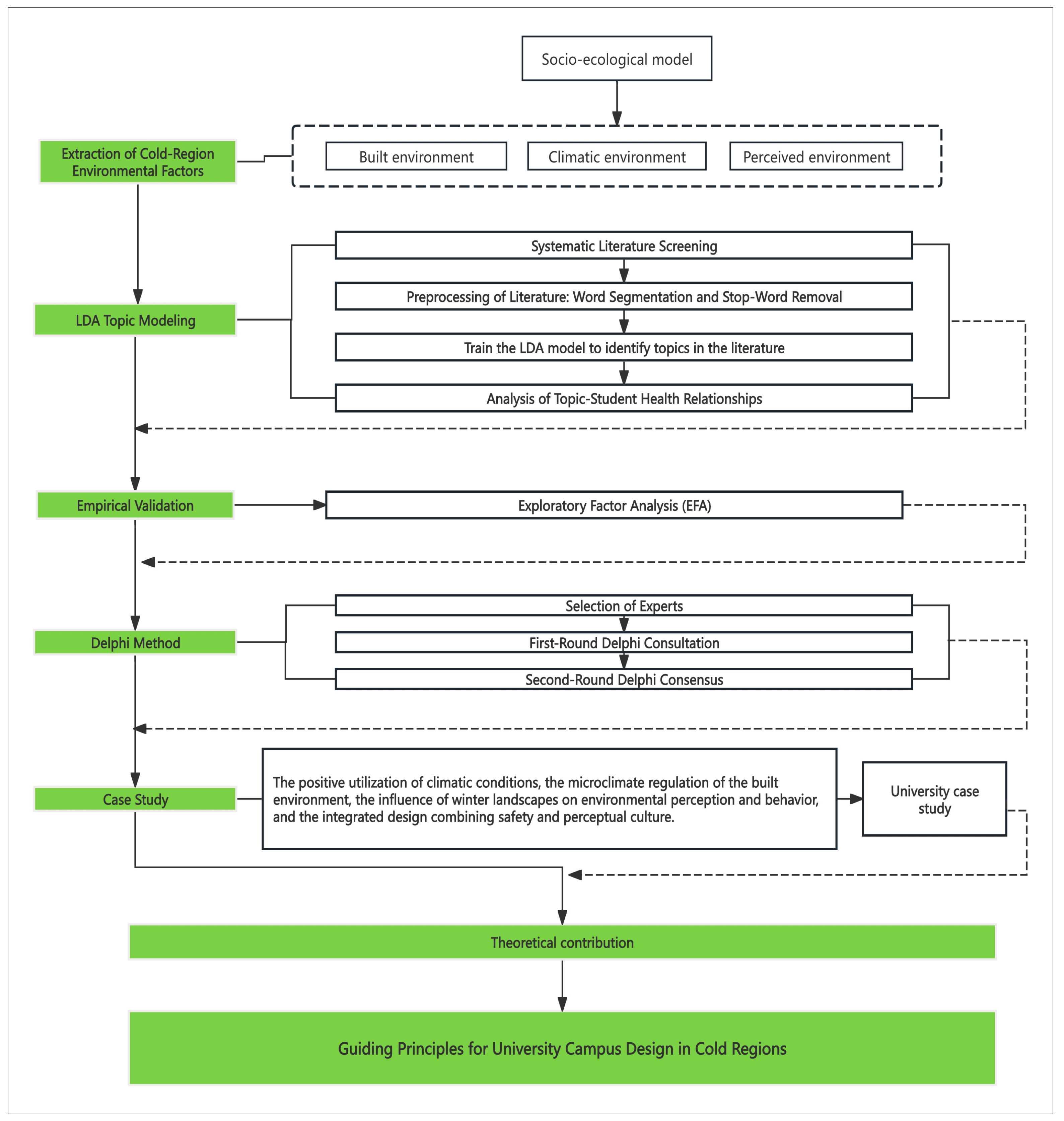

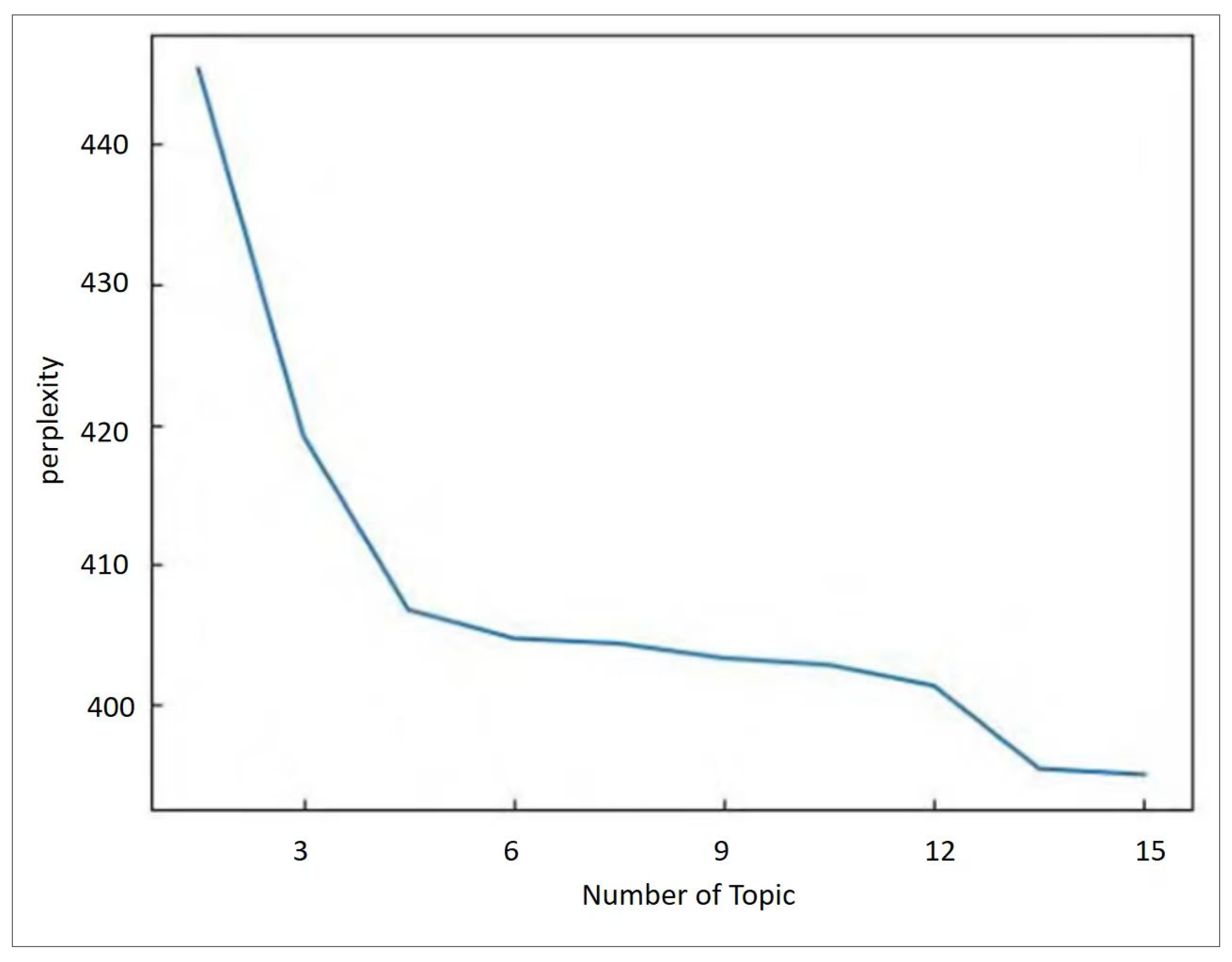
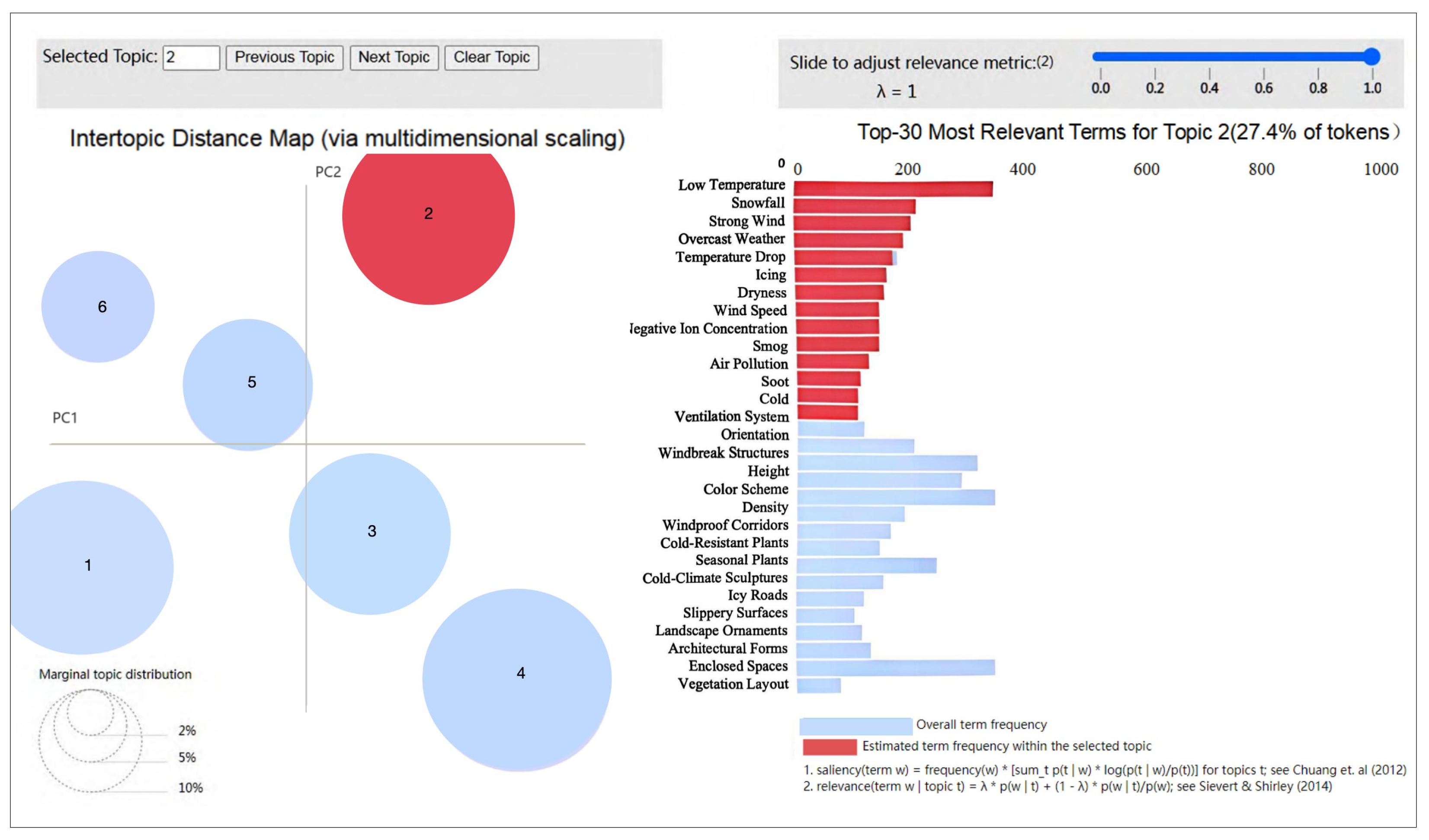
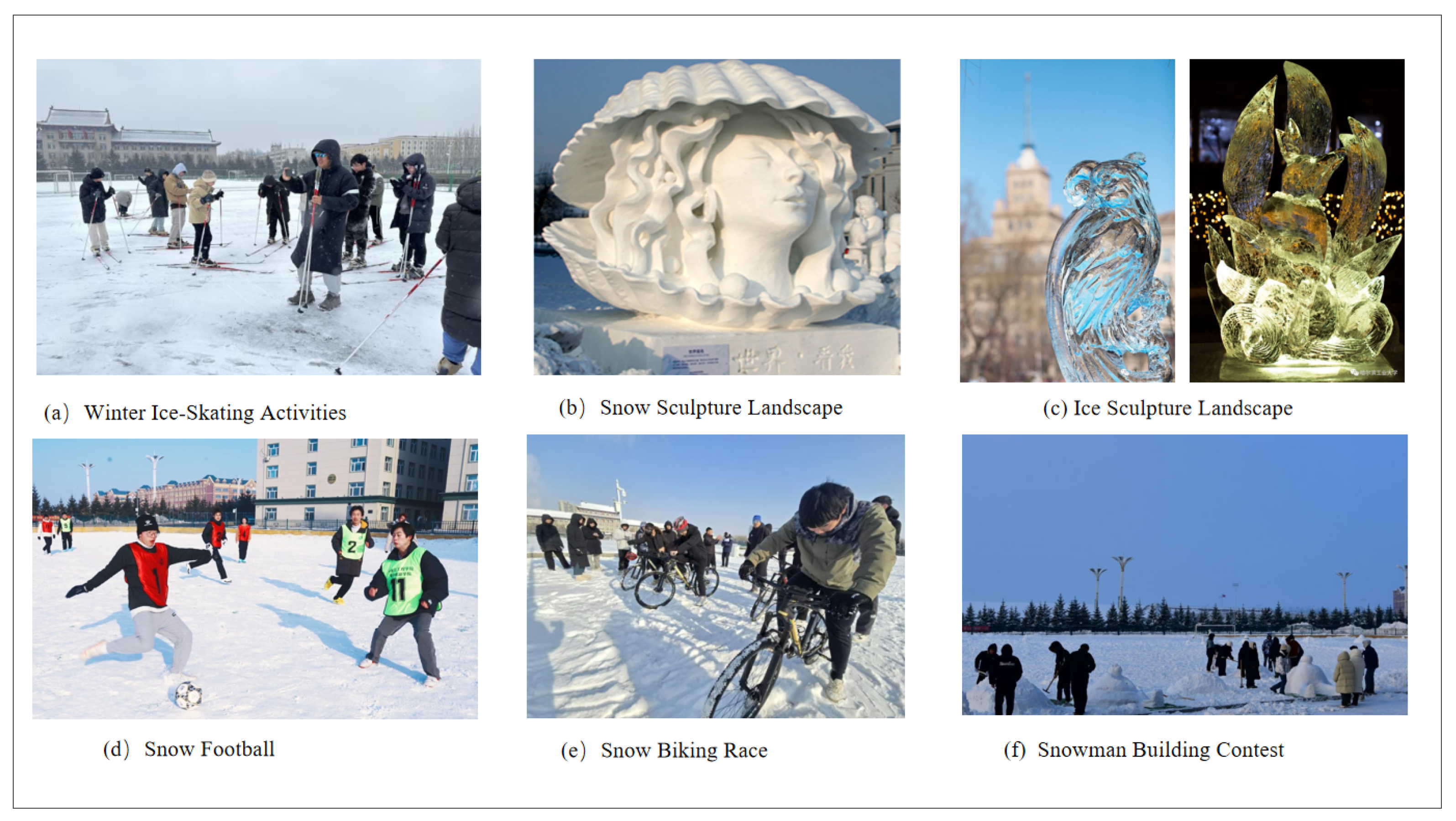
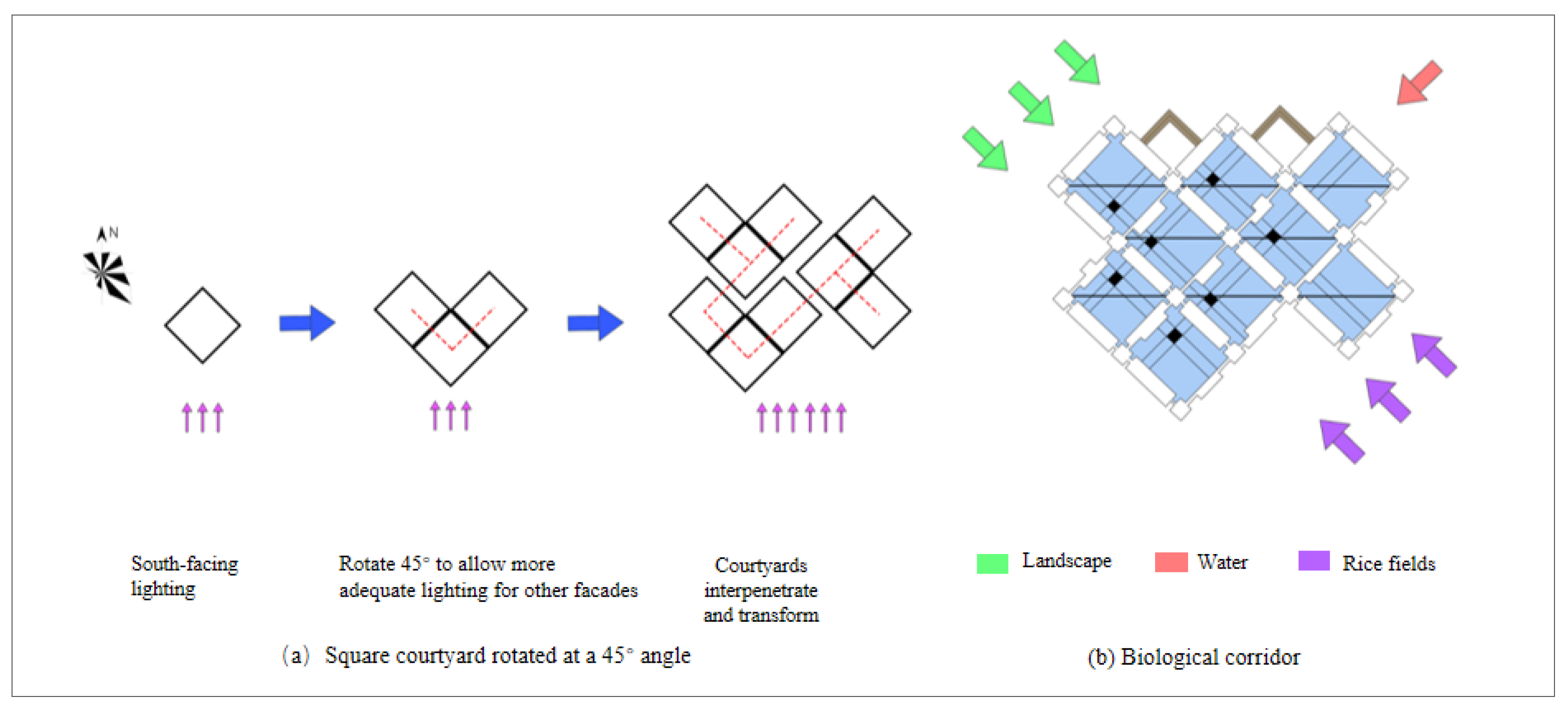


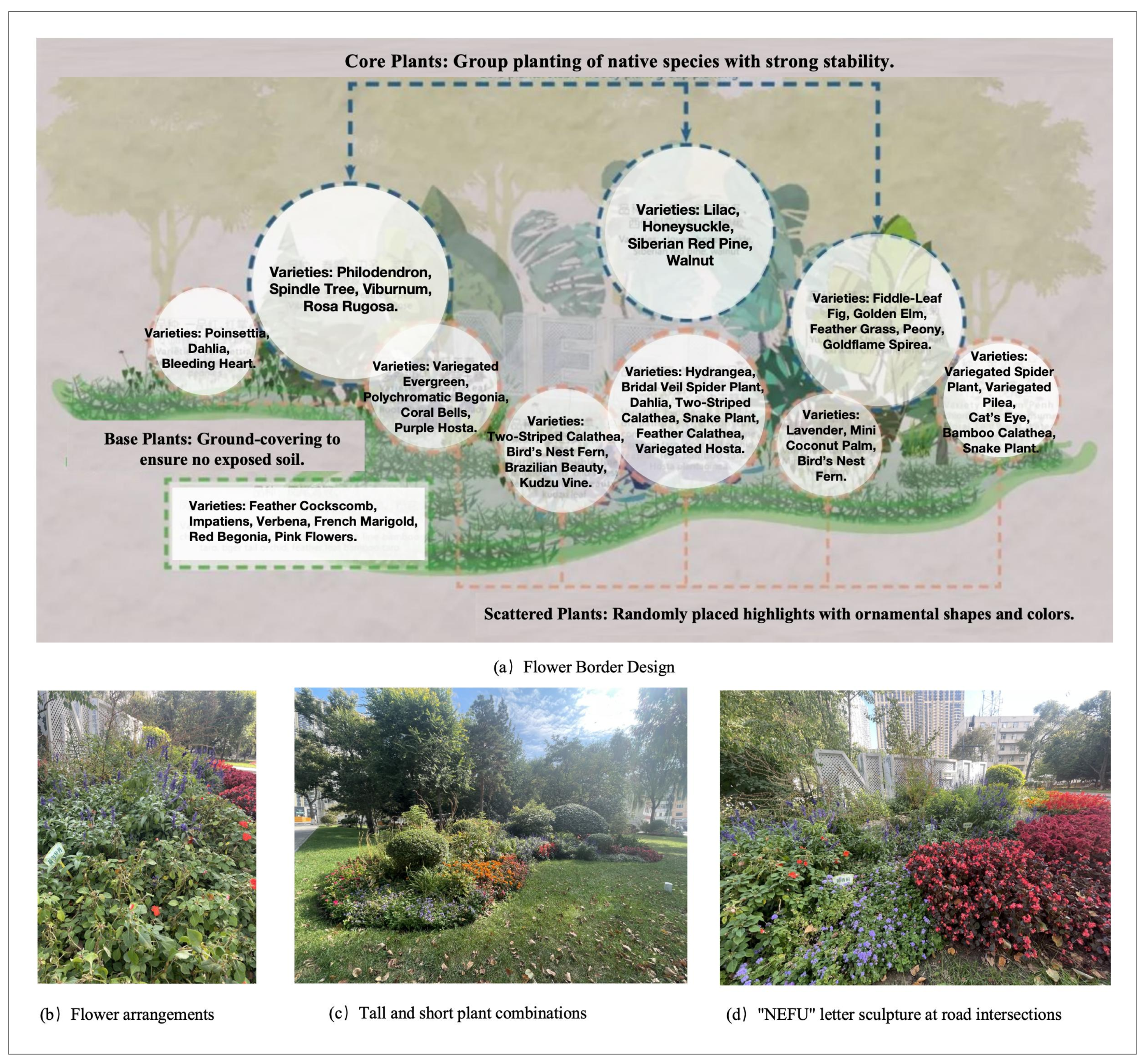
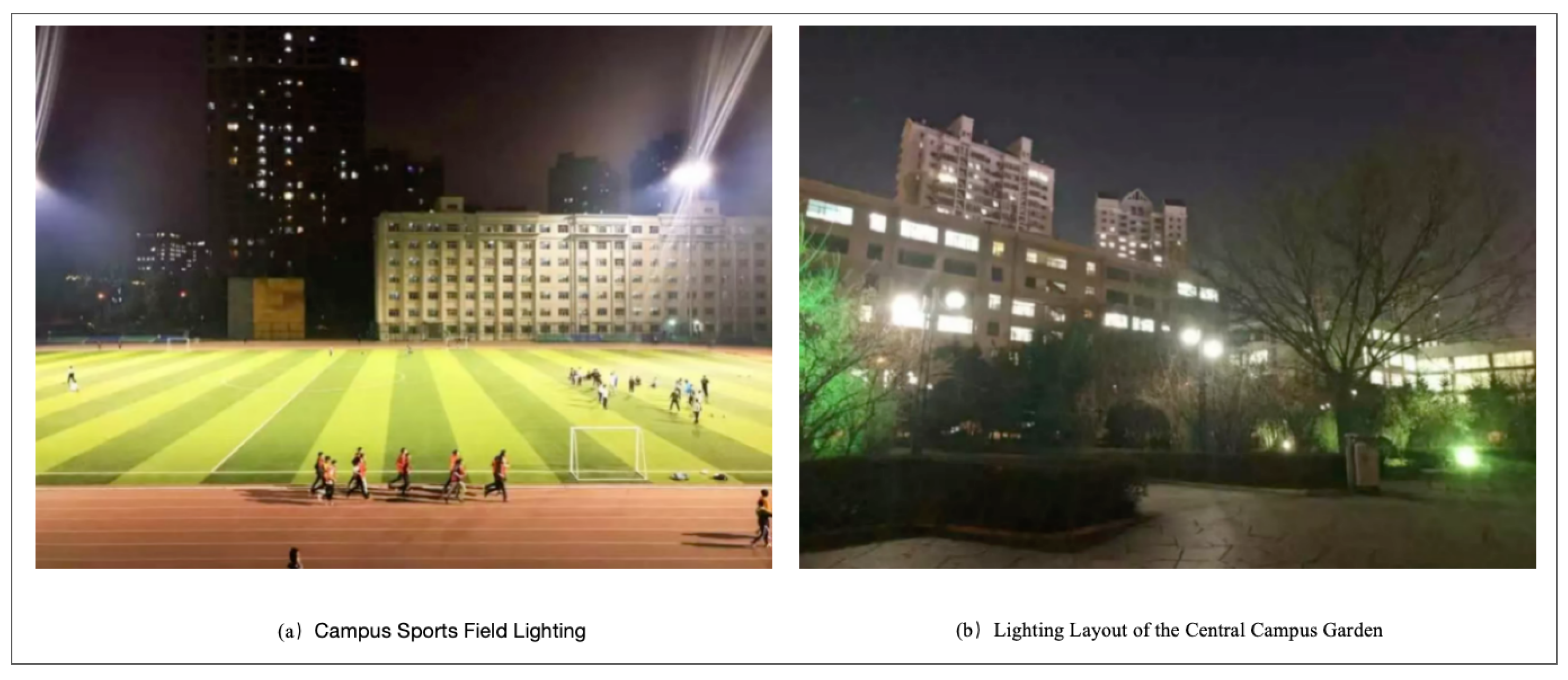
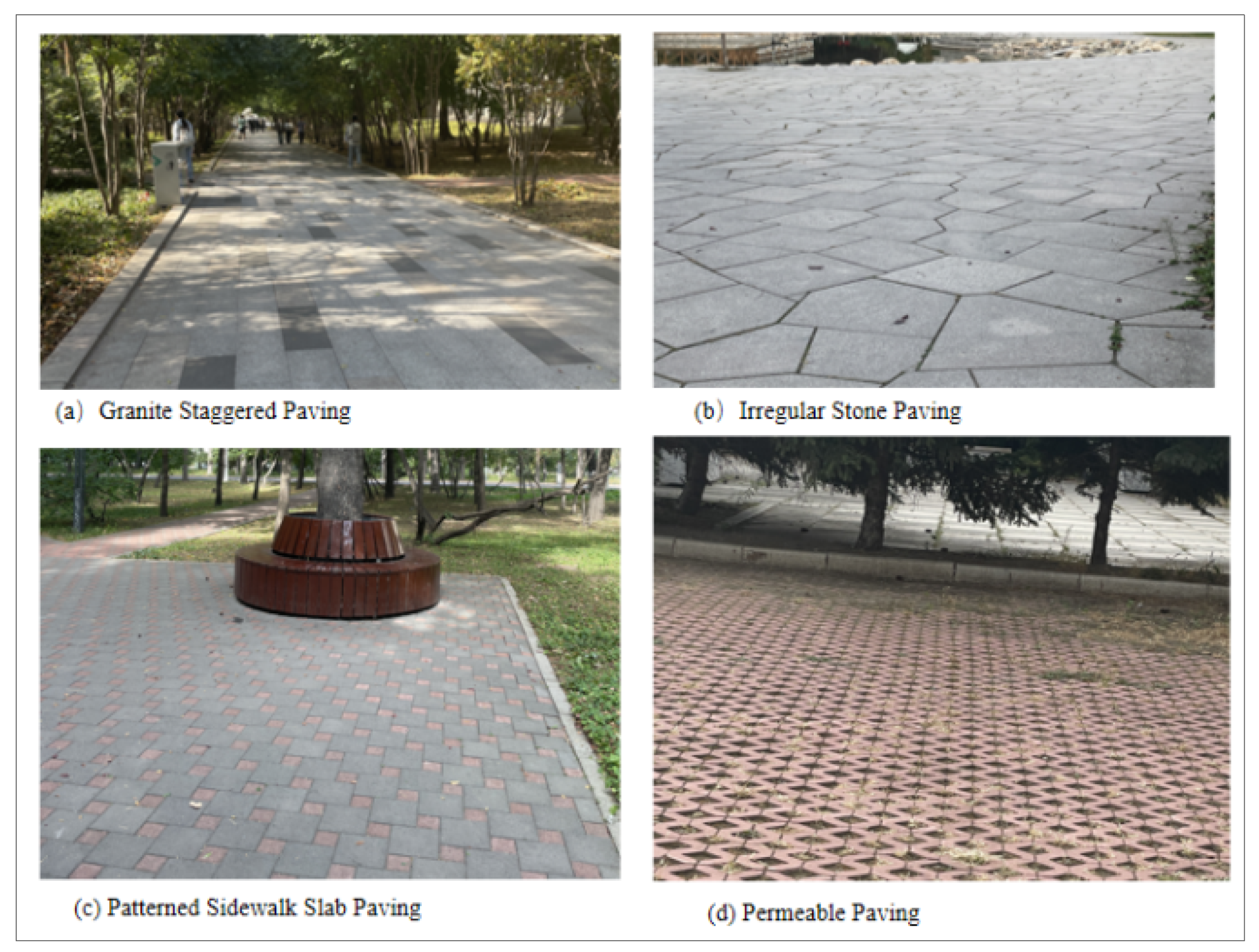
| Topic | Theme | Core Keywords | Pathway Mechanism (Mechanism Level) | Mechanistic Interpretation (Social-Ecological Level) | Socio-Ecological Perspective |
|---|---|---|---|---|---|
| Topic 0 | Climatic Conditions | Low temperature, snowfall, strong wind, sharp temperature variation, wind speed change, ice-snow utilization, dryness | Winter resource integration and utilization; outdoor microclimate regulation; protection design for extreme cold | Climatic Environment Level (Environmental Stress Theory, Climate–Health Model) | Climatic Environment |
| Topic 1 | Architectural Form | Building layout, daylighting design, orientation, insulation, building materials, corridor connection | Spatial organization and scale control; thermal-light balance | Built Environment Level (Building–Environment–Health Model) | Built Environment |
| Topic 2 | Campus Infrastructure | Anti-slip pavement, resting facilities, temporary shelters, walking paths, covered corridors, ramps, trash bins | Pedestrian facility quality; path obstacle avoidance; path interface design | Built Environment Level (Health-Supportive Environment Theory) | Built Environment |
| Topic 3 | Natural Environment and Green Space | Outdoor green classrooms, cold-resistant plants, seasonal vegetation, ice sculptures, biodiversity support, windbreak plants | Seasonal vegetation configuration; ecological protective design | Perceptual Environment Level (Biophilia and Restorative Environment Theories) | Perceived Environment |
| Topic 4 | Safety Factors | Icy roads, pathway maintenance, safety perception, lighting, surveillance, gender difference, anti-slip design | Traffic safety; crime prevention and safety; winter activity protection | Perceptual Environment Level (Safety Perception and Risk Cognition Models) | Perceived Environment |
| Topic 5 | Transportation and Accessibility | Transportation connection, public transport, pedestrian paths, bicycle lanes, parking management, walking network, tactile paving | Pedestrian system continuity; transport diversity | Built Environment Level (Active Transport and Accessibility Equity Theories) | Built Environment |
| Document ID | Topic 0 | Topic 1 | Topic 2 | Topic 3 | Topic 4 | Topic 5 | Associated Topic |
|---|---|---|---|---|---|---|---|
| 0 | 0.750125 | 0.085132 | 0.0654185 | 0.0513375 | 0.0458125 | 0.0021745 | 0 |
| 1 | 0.402548 | 0.075189 | 0.092354 | 0.352547 | 0.014865 | 0.062497 | 0 |
| 2 | 0.065485 | 0.525486 | 0.254867 | 0.075156 | 0.023545 | 0.055461 | 1 |
| 3 | 0.048456 | 0.085481 | 0.804656 | 0.016245 | 0.025485 | 0.019677 | 2 |
| 4 | 0.025489 | 0.085425 | 0.258949 | 0.0451896 | 0.012545 | 0.5724024 | 5 |
| ...... | ...... | ...... | ...... | ...... | ...... | ...... | |
| 55 | 0.155685 | 0.002545 | 0.054568 | 0.154588 | 0.025458 | 0.607156 | 5 |
| 56 | 0.065844 | 0.045264 | 0.098545 | 0.526545 | 0.125996 | 0.137806 | 3 |
| 57 | 0.025645 | 0.095465 | 0.154898 | 0.012655 | 0.648584 | 0.062753 | 4 |
| 58 | 0.751522 | 0.015456 | 0.054521 | 0.015458 | 0.054521 | 0.108522 | 0 |
| 59 | 0.025486 | 0.125485 | 0.545664 | 0.094521 | 0.05553 | 0.153314 | 3 |
| Validation Indicators | Primary Dimension | Secondary Dimension |
|---|---|---|
| Cronbach’s α Coefficient | 0.946 | 0.977 |
| Kaiser–Meyer–Olkin (KMO) Measure | — | 0.952 |
| Bartlett’s Test of Sphericity | — | p < 0.001 |
| Cumulative Variance Contribution Rate | — | 92.290% (Six factors extracted) |
| Number of Items | 6 | 13 |
| Valid Cases (N) | 480 | |
| Years of Professional Experience | Academic Title | Educational Qualification | Nationality | ||||||
|---|---|---|---|---|---|---|---|---|---|
| 10–20 Years | 20–30 Years | Over 30 Years | Lecturer | Associate Professor | Professor | Master’s Degree | Doctoral Degree | Non-Chinese | Chinese |
| 5 | 8 | 7 | 2 | 11 | 7 | 8 | 12 | 0 | 20 |
| Importance | Quantitative Value | Basis for Judgment | Quantitative Value | Proficiency Level | Quantitative Value |
|---|---|---|---|---|---|
| Very Important | 10 | Practical Experience | 0.8 | Very Familiar | 10 |
| Important | 8 | Theoretical Analysis | 0.6 | Familiar | 8 |
| Somewhat Important | 6 | Peer Understanding | 0.4 | Somewhat Familiar | 6 |
| Moderately Important | 4 | Intuition | 0.2 | Slightly Familiar | 4 |
| Not Important | 0 | Not Familiar | 0 |
| Environmental Factors | Mean | Standard Deviation | Full Score Rate | Coefficient of Variation | Secondary Indicator | Mean | Standard Deviation | Full Score Rate | Coefficient of Variation |
|---|---|---|---|---|---|---|---|---|---|
| Climate | 4.36 | 0.84 | 82.40% | 0.20 | 1. Winter Resource Integration and Utilization | 4.40 | 0.50 | 88.00% | 0.11 |
| 2. Microclimate Regulation for Outdoor Activities | 4.36 | 0.49 | 87.20% | 0.11 | |||||
| 3. Protective Design for Extreme Climatic Conditions | 4.40 | 0.50 | 88.00% | 0.11 | |||||
| Architectural Forms | 4.40 | 0.81 | 81.20% | 0.19 | 4. Spatial Layout and Organization | 4.60 | 0.50 | 92.00% | 0.11 |
| 5. Spatial Scale | 4.56 | 0.50 | 91.20% | 0.11 | |||||
| Campus Facility Characteristics | 4.32 | 0.84 | 87.30% | 0.16 | 6. Pedestrian Facility Quality | 4.36 | 0.64 | 87.20% | 0.13 |
| 7. Pathway Obstacle Avoidance | 4.44 | 0.51 | 88.80% | 0.11 | |||||
| 8. Pedestrian Pathway Interface Design | 4.44 | 0.65 | 88.80% | 0.13 | |||||
| Natural Environment and Green Spaces | 4.12 | 0.82 | 87.20% | 0.17 | 9. Seasonal Vegetation Configuration | 4.36 | 0.57 | 87.20% | 0.13 |
| 10. Utilization of Snow and Ice Resources | 4.28 | 0.58 | 85.60% | 0.14 | |||||
| Campus Safety | 4.46 | 0.84 | 88.00% | 0.19 | 11. Traffic Safety | 4.24 | 0.60 | 84.80% | 0.14 |
| 12. Crime Prevention and Safety | 4.20 | 0.65 | 84.00% | 0.15 | |||||
| 13. Safety of Winter Activities | 4.40 | 0.58 | 88.00% | 0.13 | |||||
| Campus Transportation | 4.23 | 0.88 | 85.20% | 0.21 | 14. Pedestrian Transportation System | 4.40 | 0.58 | 88.80% | 0.13 |
| 15. Diversity of Transportation Modes | 4.33 | 0.57 | 86.60% | 0.13 |
| Environmental Factors | Mean | Standard Deviation | Coefficient of Variation | Secondary Indicators |
|---|---|---|---|---|
| Climate Adaptability | 19.5 | 3.45 | 0.18 | 1. Extreme Climate Environment Protection Design |
| Architectural Forms | 26 | 4.12 | 0.20 | 2. Layout Design |
| 3. Spatial Scale | ||||
| Natural Environment and Green Spaces | 16 | 4.74 | 0.17 | 4. Seasonal Vegetation |
| 5. Utilization of Ice and Snow Resources | ||||
| Campus Safety | 16.5 | 5.87 | 0.21 | 6. Traffic Safety |
| 7. Crime Prevention and Safety | ||||
| Campus Transportation | 22 | 05.16 | 0.29 | 8. Pedestrian Transport System |
| 9. Diversity of Transportation Modes |
| Dimension | Type of Intervention | Behavioral Response | Health Promotion Mechanism | Case Example |
|---|---|---|---|---|
| Climate Condition Utilization | Climate resource transformation | Increased participation in outdoor activities | Enhanced physical activity level | Harbin Engineering University—Winter Carnival |
| Built Environment Design | Microclimate optimization and integrated circulation | Improved travel willingness and comfort | Promotion of daily walking | Shenyang Jianzhu University—Building layout; Xi’an Eurasia University—Wind-proof design; Harbin Institute of Technology—Corridor system |
| Landscape and Ecological Strategy | Aesthetic and nature-based experience | Enhanced emotional stability and pro-environmental behavior | Improved mental health | Northeast Forestry University—Four-season landscape design |
| Safety and Accessibility | Protective and guidance-oriented design | Extended activity duration and spatial range | Reduced risk perception and anxiety | Heilongjiang Institute of Technology—Hierarchical lighting system; Northeast Agricultural University—Anti-slip permeable pavement |
Disclaimer/Publisher’s Note: The statements, opinions and data contained in all publications are solely those of the individual author(s) and contributor(s) and not of MDPI and/or the editor(s). MDPI and/or the editor(s) disclaim responsibility for any injury to people or property resulting from any ideas, methods, instructions or products referred to in the content. |
© 2025 by the authors. Licensee MDPI, Basel, Switzerland. This article is an open access article distributed under the terms and conditions of the Creative Commons Attribution (CC BY) license (https://creativecommons.org/licenses/by/4.0/).
Share and Cite
Li, C.; Maruthaveeran, S.; Shahidan, M.F.; Tao, Z.; Wang, Z. A Multi-Factor Framework for Cold-Climate Campus Design and Student Health. Buildings 2025, 15, 4133. https://doi.org/10.3390/buildings15224133
Li C, Maruthaveeran S, Shahidan MF, Tao Z, Wang Z. A Multi-Factor Framework for Cold-Climate Campus Design and Student Health. Buildings. 2025; 15(22):4133. https://doi.org/10.3390/buildings15224133
Chicago/Turabian StyleLi, Caili, Sreetheran Maruthaveeran, Mohd Fairuz Shahidan, Zhongjun Tao, and Zhichen Wang. 2025. "A Multi-Factor Framework for Cold-Climate Campus Design and Student Health" Buildings 15, no. 22: 4133. https://doi.org/10.3390/buildings15224133
APA StyleLi, C., Maruthaveeran, S., Shahidan, M. F., Tao, Z., & Wang, Z. (2025). A Multi-Factor Framework for Cold-Climate Campus Design and Student Health. Buildings, 15(22), 4133. https://doi.org/10.3390/buildings15224133







